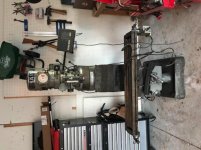What you have, as JDLeach noted, is a Bridgeport clone. It has the variable speed head, so it is not so simple a matter as finding the right motor. Whether Bridgeport parts will drop right in is something I do not know. I'd start by measuring the mounting for the motor. This set of dimensions can then be compared to NEMA standard frame dimensions for flange-mount motors. That is step 1, in my opinion. A Bridgeport 2J head mill typically had a NEMA 145 TY frame motor rated at 1.5 HP.
The "on/off" switch is simply a drum type reversing switch. Nothing unique to Bridgeport, other than they labelled the switch for high and low ranges. The motor rotates in one direction to drive the spindle for high range (direct belt drive) milling, and in opposite direction when the low range (reduction gearing) is engaged- this being to get that same spindle rotation as in high range.
If a standard NEMA frame motor drops into the mounting on the head of your Sharp milling machine, you are way ahead of the game. Obtaining a motor from Grainger or similar would solve a big piece of your problem. Again, first step is to measure the bored fit in the head of your mill and determine the exact diameter using a dial caliper or a good machinist rule or combination square blade, and then determine the bolt size and bolt circle diameter to mount the motor.
As for the variable speed pulley, I'd be surprised if Sharp did not copy Bridgeport "line for line". As the saying goes: "Imitation is the sincerest form of flattery". Bridgeport had come up with a winning design, and it was shamelessly copied by a variety of Asian makers. Some were so shameless that they attached the names of US cities to their Asian knock-offs, hoping someone would be dumb enough to believe it was a good solid US made mill.
I think Sharp may still be in business, selling Asian made machine tools in the USA. Whether they support the older machine tools like your mill is something I do not know. I'd contact Sharp. JDLeach is right about the theory of design for the Asian machine tools. I've heard them referred to as "five year throwaways". I've seen some of the castings in Chinese Bridgeport clones. What I saw was horrible to behold, lost foam used for the patterns, with the cellular pattern of the foam clearly visible on the inside of the mainframes when I opened the cabinet doors, and the castings looked punky and thin compared to an original US made Bridgeport. This was on some "Chevalier" mills. Sharp, by word of mouth, had a better reputation than the generic Chinese Bridgeport clones.
If you strike out on the matter of finding the variable speed parts, you might think of installing a 1:1 vee belt drive and using a 3 phase motor with variable frequency converter (VFD). This is actually a step up from the variable speed belt drive, in my opinion. You still have the low range gear drive, and about all you lose is a little on the upper end speeds, but unless you are going to be running some very small diameter end mills (the kind that bust if you breathe hard), you won't miss those upper end speeds.
Another idea is simply to hunt up a used Bridgeport J series head or one of the clones and mount it on the ram of the mill you have. You might find a used milling head is less money than a new flange mount motor, reversing switch, and the parts for the variable speed belt drive.





